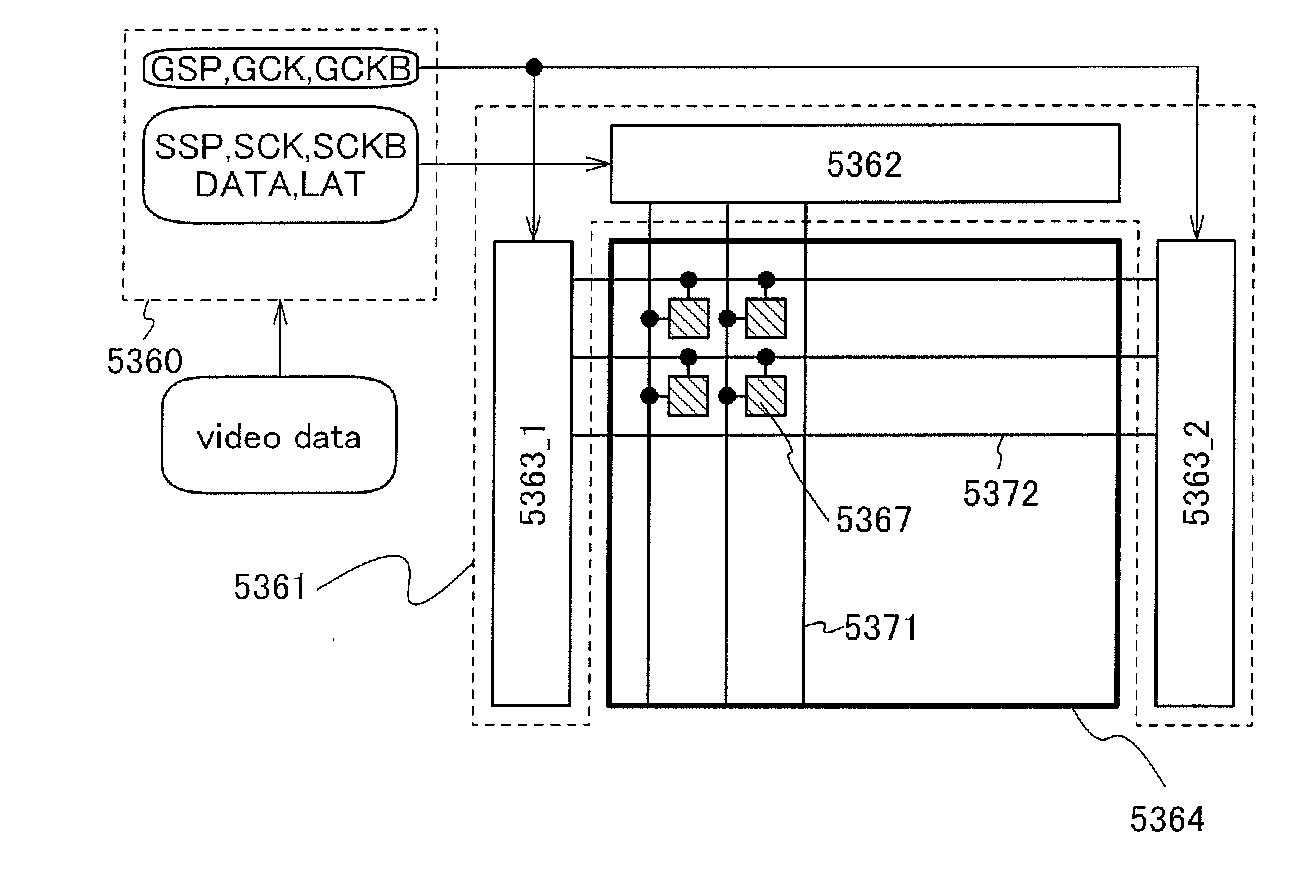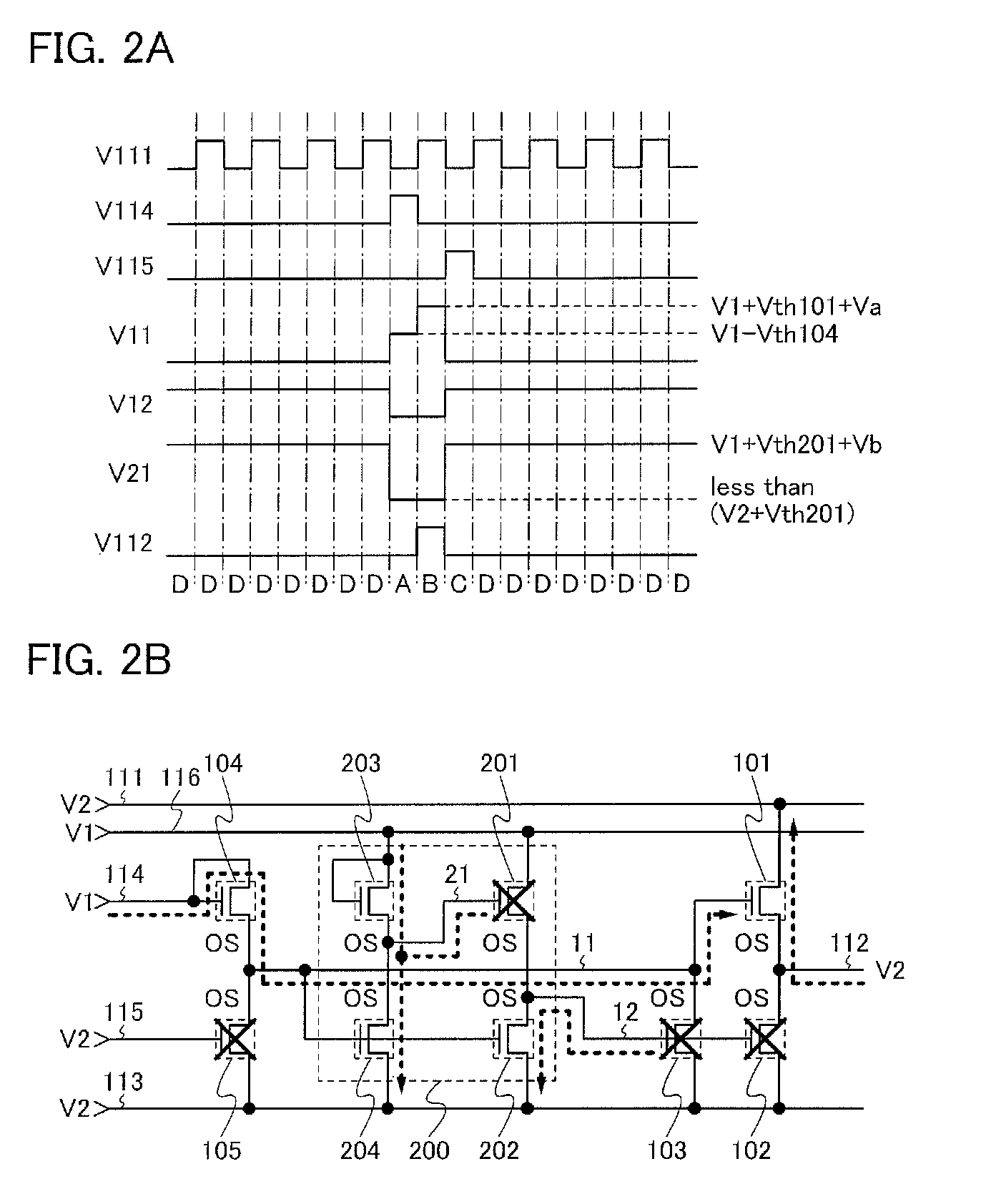Pulse signal output circuit and shift register
- Summary
- Abstract
- Description
- Claims
- Application Information
AI Technical Summary
Benefits of technology
Problems solved by technology
Method used
Image
Examples
embodiment 1
[0039]In this embodiment, a circuit in a display device which is one embodiment of the present invention is described.
[0040]FIG. 1A illustrates a structure example of a circuit which includes a transistor 101, a transistor 102, a transistor 103, a transistor 104, a transistor 105, and a circuit 200. The transistors included in the circuit illustrated in FIG. 1A are n-channel transistors. An n-channel transistor is turned on when a potential difference between a gate and a source is higher than the threshold voltage.
[0041]Note that an oxide semiconductor may be used for a semiconductor layer of the transistor included in the circuit illustrated in FIG. 1A. It is preferable that the oxide semiconductor be an intrinsic (i-type) or substantially intrinsic oxide semiconductor which is obtained by sufficiently lowering a hydrogen concentration to be highly purified and has sufficiently low carrier density. With the oxide semiconductor, the subthreshold swing of the transistor can be decre...
embodiment 2
[0080]In this embodiment, a shift register circuit in a display device which is one embodiment of the present invention is described. A shift register circuit in this embodiment can include any of the circuits described in Embodiment 1. Further, the shift register circuit in this embodiment can be used as a driver circuit of a display device, such as a gate driver circuit and / or a source driver circuit.
[0081]FIG. 11 illustrates a structure example of a shift register circuit which includes N (N is a natural number) pieces of circuits 301 (circuits 301_1 to 301_N). Any of the circuits described in Embodiment 1 can be used as the circuit 301. FIG. 11 illustrates an example in which the circuit illustrated in FIG. 1A is used as the circuit 301.
[0082]Connection relations in the shift register circuit illustrated in FIG. 11 are described. The connection relation in a circuit 301—i (i is a natural number that is 2 or more and less than N−1) is described as an example. The circuit 301—i is...
embodiment 3
[0088]In this embodiment, an example of a transistor included in the circuit described in Embodiment 1 or 2 is described. Specifically, examples of the structure of a transistor whose channel region includes an oxide semiconductor and manufacturing steps thereof are described.
[0089]As the oxide semiconductor, the following oxides can be used: an In—Sn—Ga—Zn—O-based oxide semiconductor that is an oxide of four metal elements; an In—Ga—Zn—O-based oxide semiconductor, an In—Sn—Zn—O-based oxide semiconductor, an In—Al—Zn—O-based oxide semiconductor, a Sn—Ga—Zn—O-based oxide semiconductor, an Al—Ga—Zn—O-based oxide semiconductor, or a Sn—Al—Zn—O-based oxide semiconductor that is an oxide of three metal elements; an In—Zn—O-based oxide semiconductor, a Sn—Zn—O-based oxide semiconductor, an Al—Zn—O-based oxide semiconductor, a Zn—Mg—O-based oxide semiconductor, a Sn—Mg—O-based oxide semiconductor, or an In—Mg—CD-based oxide semiconductor that is an oxide of two metal elements; an In—O-base...
PUM
 Login to View More
Login to View More Abstract
Description
Claims
Application Information
 Login to View More
Login to View More - R&D
- Intellectual Property
- Life Sciences
- Materials
- Tech Scout
- Unparalleled Data Quality
- Higher Quality Content
- 60% Fewer Hallucinations
Browse by: Latest US Patents, China's latest patents, Technical Efficacy Thesaurus, Application Domain, Technology Topic, Popular Technical Reports.
© 2025 PatSnap. All rights reserved.Legal|Privacy policy|Modern Slavery Act Transparency Statement|Sitemap|About US| Contact US: help@patsnap.com



